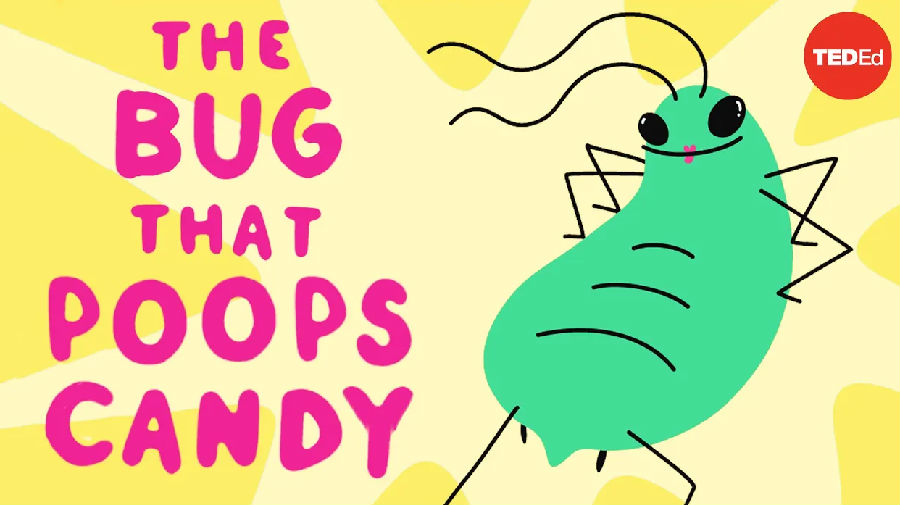This is Mabel. Mabel is an aphid, a small insect in the same order as cicadas, stink bugs, and bed bugs.
这是Mabel。Mabel是一种蚜虫,它是一种小型昆虫,与蝉、椿象和床虱同属于半翅目。
All these bugs pierce their prey and suck out vital fluids.
它们都会刺破猎物并吸取对其十分重要的汁液。
Aphids' prey are plants. And what aphids are after is buried within the plant, flowing in tubes made from single cells strung end-to-end.
蚜虫的猎物是植物。它们吸食的物质存在于植物内部,这些物质在串联的单细胞管道内来回流动。
These are called sieve tubes and together they form the plumbing system for a plant's most valuable resource: sap.
这些管道被称为筛管,它们共同构成了植物的管道系统,运输植物中最重要的资源:树液。
Sap is mostly water and sugar. Some species' sap has as much sugar per liter as a can of soda. Photosynthesis is constantly producing sugar.
树液主要包含水和糖分。有些种类的树液每升的含糖量堪比一罐可乐。光合作用会一直产生糖分。
You can think of it as a chemical "pump" which generates incredibly high pressure -- up to 9 times that of a car tire -- in the sieve tubes.
你可以把它看成一个化学“泵”,会产生难以置信的高压--筛管中的压力最高可达汽车胎压的9倍。
To feed, Mabel uses her stylet, which is a long, flexible needle.
Mabel用它长长的、柔韧的针管状口器来进食。
She slowly worms it into the tissue, between the plant's cells, until she pierces one of those sieve tubes.
它慢慢地将口器探进植物细胞间的组织中去,直到它刺穿一个筛管。
Because the sap is under so much pressure, Mabel doesn't even have to suck it out of the plant.
因为树液有很高的液压,Mabel甚至不需要费劲地吮吸树液。
She just opens a valve in her head and lets the pressure push the sap through her digestive system.
它只需要打开头部的阀门,然后液压会把树液推入消化系统。
We'll come back to what comes out of her butt, but for now, you should know that plants don't want to be punctured and sipped.
我们待会儿再说它从屁股里排出了什么,但是现在,你应该知道植物并不想被刺破然后被吸食树液。
So they try to defend themselves. One defense is the sap itself.
所以它们会尝试保护自己。一种保护方式是利用树液本身。
To see how that works, let's hypothetically hook up some other insect's digestive tract to a steady stream of sap.
要想了解其工作原理,我们先假设性地让树液稳定地流过别的昆虫的消化道。
When that sap touches the insect's cells, its high sugar content encourages the water in the cells to come out by osmosis
当树液接触到昆虫的细胞时,它的高糖成分会促使水分通过渗透作用从细胞中流失,
exactly like salt encourages water to come out of a slug.
就像盐促使水分从蛞蝓中流失一样。
The more sap that passes through the insect, the more water it loses. Eventually, it shrivels up and dies.
越多的树液流过昆虫的身体,昆虫就会损失越多的水分。最终,它会脱水而死。
Mabel's gut, however, is packed with an enzyme called sucrase,
然而,Mabel的肠子里充满了蔗糖酶,
which takes two molecules of sucrose and converts them into one molecule of fructose and one of... this three-unit sugar.
它会把两个蔗糖分子转化为一个果糖分子和一个三分子糖。
Mabel burns the fructose for energy, leaving the three-unit-sugar behind. Now, how does that help her?
Mabel把果糖作为能量消耗掉,留下这个三分子糖。那么,这是怎么帮助蚜虫的呢?
The more molecules of sugar that are dissolved in the sap, the more water it can suck out of Mabel's cells.
越多的糖分子溶解在树液中,越多的水分就会从Mabel的细胞中被吸出。

By reducing the number of molecules of sugar in the sap, Mabel reduces its ability to suck water out of her cells.
通过减少树液中的糖分子数,Mabel就减轻了树液吸取自身水分的能力。
Plant sap neutralized. Now that means Mabel can feed for days, getting all the energy she needs to reproduce.
植物的树液失效了。这意味着Mabel可以连续进食多日,得到繁殖所需要的所有能量。
Some aphid species have an incredible life cycle. For example, the green peach aphid.
一些蚜虫有着难以置信的生命周期。比如,桃蚜。
During the fall, males and females mate, and the females lay eggs. But in the spring, when the eggs hatch, all the nymphs that emerge are female.
秋天,雌雄交合,雌性产卵。到了春天,当卵被孵化,所有生出来的若虫都是雌性。
When those females reach maturity, they don't lay eggs.
当这些雌虫成熟后,它们不会产卵。
Instead, they give birth to live young... that are clones of themselves... and already pregnant... with their own clones.
而是直接克隆自己产生后代...而这些克隆的后代也是已经怀孕的...怀着自己的克隆体。
So, these female aphids have two generations of baby aphid clones forming inside themselves at the same time.
所以,这些雌性蚜虫的体内同时孕育着两代蚜虫克隆体。
Scientists call this telescopic development.
科学家称之为重代。
That means that aphids can make more of themselves fast -- there can be 20 generations within a single season -- and that means lots of aphid poop.
它意味着蚜虫能更快地繁殖后代--一个季节可以有20代蚜虫出生--而这也意味着大量的蚜虫粪便。
Mabel can poop her entire body weight every two hours, making her one of the most prolific poopers on the planet.
Mabel每两个小时可以排出相当于自身重量的粪便,是这个星球上排便最多的生物之一。
Some aphid populations can produce hundreds of kilograms of poop per acre.
一些种群的排便量甚至高达每英亩几百公斤。
Now, aphid poop is not like your poop. Chemically, it's not all that different from sap; it's a clear and colorless sweet, syrupy liquid.
不过,蚜虫的粪便可不像你的粪便。从化学组成上说,它和树液也差不多。它是纯净的无色糖浆。
You might already know it by a different name: honeydew. Other species love honeydew.
你可能已经知晓它的另一个名字:蜜露。有些生物很爱蜜露。
Some species of ants love it so much they sort of herd and defend entire aphid colonies.
一些蚂蚁是如此地喜爱蜜露,它们甚至会在某种程度上聚集并捍卫整个蚜虫群。
In return, the ants get a steady supply of sweet honeydew, which they can drink directly from the aphids' butts. Bottom's up!
作为回报,蚂蚁得到了稳定的蜜露供应,它们可以直接从蚜虫屁股里喝蜜露。喝光!
Humans love honeydew, too. Several Native American tribes used to harvest it from tall reeds and make it into cake.
人类也爱蜜露。一些美洲原始部落从高高的芦苇上采集蜜露,然后做成蛋糕。
And some species of bee make honey from honeydew, which humans then harvest and eat.
一些种类的蜜蜂采集蜜露来酿造蜂蜜,然后人类采集蜂蜜并吃掉。
So plants make the sap, which is eaten and pooped out by aphids, regurgitated by bees, harvested by humans, and dolloped into a cup of Earl Grey tea.
所以植物产生树液,蚜虫吸食树液,排出蜜露,蜜蜂采集蜜露,酿成蜂蜜人类采集蜂蜜,挖出一勺,调入了一杯伯爵茶。


